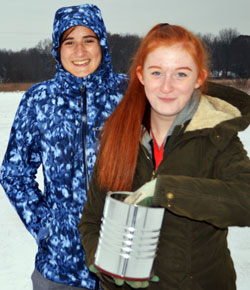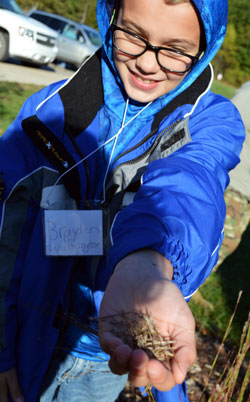Motorists passing by the Wittenbach/Wege Agriscience and Education Center on a snowy Thursday afternoon might have wondered at the scene that played out in the vacant field just west of the center’s barn.
Nearly 20 high school students walked slowly southward in a row that spanned nearly 100 feet, from pink-flagged posts on one end of the field to pink-flagged posts on the other end.

As they walked, they dug their bare hands into coffee cans and ice cream tubs that held a mixture of vermiculite and native plant seeds: scoop, step, toss left, toss right… scoop, step, toss left, toss right…
Snow on the ground and rain in the forecast made for perfect conditions to spread seed for the center’s planned pollinator prairie. All that white stuff helped students see where seed had been spread, and rain would work the seed close to the ground, where it would again be covered with snow.
Junior Brayden Race explained that the new pollinator prairie “will draw in different plants and insects, which means healthier plants, healthier trees, and a healthier ecosystem all around.”
Like most all-around healthier things, the prairie will take time to blossom to its full glory.
Center Director Courtney Cheers said students and visitors won’t notice much at all happening in the 5.1-acre area until spring 2021. Before then, the seeds will be busy underground, germinating and spreading their roots. But by year three: Blammo! Pollinator prairie palooza.

A Massive Effort
Students at all grade levels — and even school staffers — lent hands this school year to begin to restore the area as native prairie and pollinator habitats.
The roots of the effort go back about a year, when Cheers proposed it for the area previously used by the high school’s agriculture students.
The aim is to increase the center’s native pollinator population in order to boost habitat for birds and wildlife, keep invasive species from spreading and improve soil health. A pollinator is an animal — think bees, bats and hummingbirds, for example — that removes pollen from and fertilizes flowers. Not only ornamental flowers, but those of fruits and vegetables.
In the fall, teachers involved in a professional development program at the center, through environmental learning coalition Groundswell, spent a day harvesting and cleaning native seeds on the property. Classrooms in every grade in the district also participated.
“My students love to be able to do the hands-on work offered (at the Wittenbach),” said Carla Wobma, third-grade teacher at Alto Elementary. “Working with the seeds, whether it be prepping or planting, gives students a chance to reflect on how we can change our environment for the better. We also discussed how changing that environment can positively affect the animals living in that habitat.”
Plants native to Michigan are the preferred species for this habitat restoration and conservation project. They also are becoming more sought after for residential landscaping.
But seeds can be very costly — about $1,200 per acre, Cheers said. That’s why the work of students and staff was so important.
More than 12 pounds of seed was harvested and cleaned for the project, largely from the center property itself. Seeds collected at the center included bee balm, coreopsis, butterfly milkweed, coneflower, little bluestem grass and rattlesnake master.

Lessons Will Bloom
The Land Conservancy and a handful of other municipally owned areas also gave permission to harvest seed for the project, and individuals with native plant gardens dropped off seed donations throughout the fall, she said.
“My students loved trying to locate the seeds to make sure they got them in the correct spots,” said Katherine Wills, a teacher at Murray Lake Elementary. “I think they liked the idea that they were doing something that would help the Wittenbach, and (would) be able to come back in the future and see the plants that have grown.”
Wobma agreed.
“The best part or these projects is returning later in the year and seeing the fruits of students’ labor. Cheers is great at reminding students of the work they completed and how it positively affects our world.”













